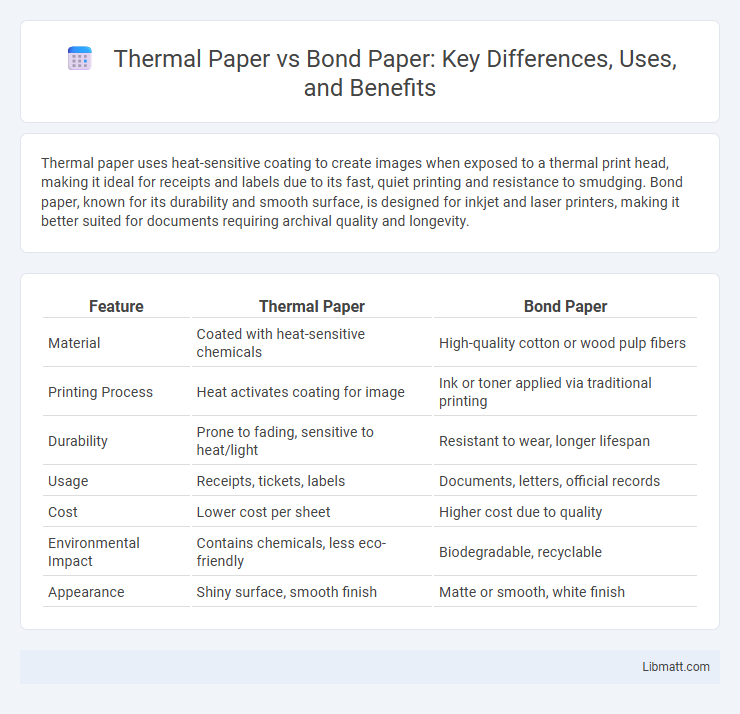Thermal paper uses heat-sensitive coating to create images when exposed to a thermal print head, making it ideal for receipts and labels due to its fast, quiet printing and resistance to smudging. Bond paper, known for its durability and smooth surface, is designed for inkjet and laser printers, making it better suited for documents requiring archival quality and longevity.
Table of Comparison
| Feature | Thermal Paper | Bond Paper |
|---|---|---|
| Material | Coated with heat-sensitive chemicals | High-quality cotton or wood pulp fibers |
| Printing Process | Heat activates coating for image | Ink or toner applied via traditional printing |
| Durability | Prone to fading, sensitive to heat/light | Resistant to wear, longer lifespan |
| Usage | Receipts, tickets, labels | Documents, letters, official records |
| Cost | Lower cost per sheet | Higher cost due to quality |
| Environmental Impact | Contains chemicals, less eco-friendly | Biodegradable, recyclable |
| Appearance | Shiny surface, smooth finish | Matte or smooth, white finish |
Introduction to Thermal Paper and Bond Paper
Thermal paper features a heat-sensitive coating that reacts when exposed to thermal printers, producing images without the need for ink, making it ideal for receipts and tickets. Bond paper, known for its durability and smooth finish, is commonly used for writing, printing, and official documents, providing high-quality text and image reproduction. Your choice depends on whether you prioritize quick, cost-effective printing or long-lasting, professional document quality.
Composition and Manufacturing Processes
Thermal paper is coated with a chemical layer that reacts to heat, eliminating the need for ink and allowing images to form directly on the surface during printing. Bond paper, made primarily from cotton or wood pulp fibers, undergoes a traditional papermaking process, producing a durable and smooth texture suitable for writing and printing with ink. Understanding these distinct compositions and manufacturing techniques helps you choose the right paper type based on your printing needs and durability requirements.
Printing Technologies: How Each Paper Works
Thermal paper is designed for direct thermal printing, where heat-sensitive chemical coatings react to heat from the printer's thermal head to produce images without using ink or toner. Bond paper relies on traditional printing technologies such as inkjet or laser, where ink or toner is applied to the surface to create printed text or images. Thermal printing offers fast, quiet, and smudge-free output, while bond paper provides better durability and compatibility with various printing methods for long-lasting documents.
Cost Comparison: Thermal Paper vs Bond Paper
Thermal paper generally costs more than bond paper due to its special coating that enables heat-sensitive printing technology. Bond paper, made primarily for everyday printing and writing, offers a more affordable option for bulk purchases and standard use. Your choice between thermal and bond paper depends largely on the specific application and budget constraints, balancing initial cost with printing needs.
Print Quality and Durability
Thermal paper offers high print quality with sharp, clear images due to its heat-sensitive coating, making it ideal for receipts and labels but tends to fade over time when exposed to heat or light. Bond paper provides durable, long-lasting prints suitable for official documents, as its ink absorption ensures resistance to smudging and fading under normal conditions. Choosing between thermal and bond paper depends on the need for temporary, high-contrast prints versus archival-quality, durable documents.
Environmental Impact and Sustainability
Thermal paper often contains BPA or BPS chemicals that pose environmental and health risks during production, use, and disposal, making it less sustainable compared to bond paper. Bond paper, typically made from wood pulp with fewer harmful additives, is more biodegradable and recyclable, contributing to a lower environmental footprint. Selecting recycled and chlorine-free bond paper enhances sustainability by reducing deforestation and chemical pollution associated with traditional paper manufacturing.
Common Applications and Use Cases
Thermal paper is commonly used in receipt printers, point-of-sale systems, and shipping labels due to its heat-sensitive coating that enables fast, inkless printing. Bond paper is favored for office printing, letterheads, and official documents because of its durability, smooth texture, and ability to hold ink well. Businesses often choose thermal paper for transactional printing and bond paper for formal communications and high-quality printing tasks.
Storage and Handling Requirements
Thermal paper requires careful storage in a cool, dry environment to prevent fading and discoloration caused by heat, moisture, and exposure to light, with an ideal temperature range between 20-25degC and relative humidity of 45-60%. Bond paper exhibits greater durability under various environmental conditions and can be stored without special temperature control, though it should be kept away from excessive moisture to avoid warping. Proper handling of thermal paper involves minimizing direct contact with fingers to reduce oil contamination that can impair print quality, while bond paper is more resistant to handling issues and is better suited for archival purposes.
Security Features and Tamper Resistance
Thermal paper features inherent security elements such as heat-sensitive coatings that reveal tampering through color changes or fading, making unauthorized alterations easily detectable. Bond paper, often used for official documents, incorporates watermarks, security threads, and special fibers to enhance tamper resistance and prevent counterfeiting. The choice between thermal and bond paper depends on specific security needs, with thermal paper excelling in quick transaction environments and bond paper suited for high-security document applications.
Choosing the Right Paper for Your Business
Thermal paper offers fast, high-quality printing ideal for receipts and labels, reducing ink costs and maintenance with heat-sensitive technology. Bond paper provides durability and versatility, perfect for official documents, forms, and business correspondence requiring a professional appearance. Choosing the right paper for your business depends on your printing needs, with thermal paper excelling in speed and convenience while bond paper supports long-lasting, archival-quality documents.
thermal paper vs bond paper Infographic

 libmatt.com
libmatt.com